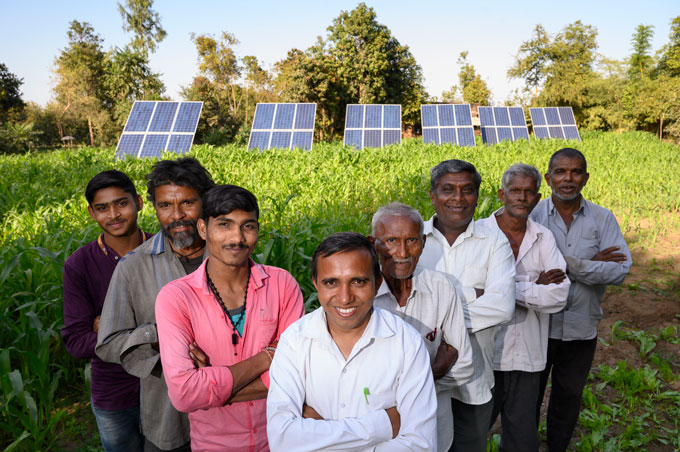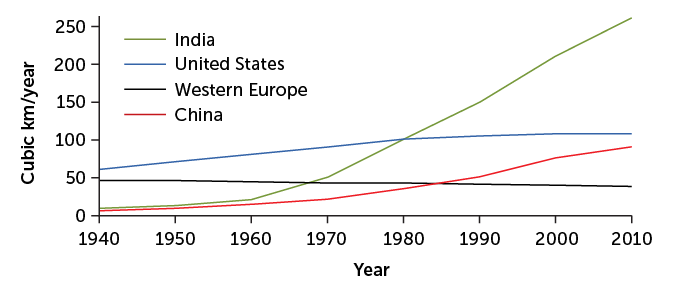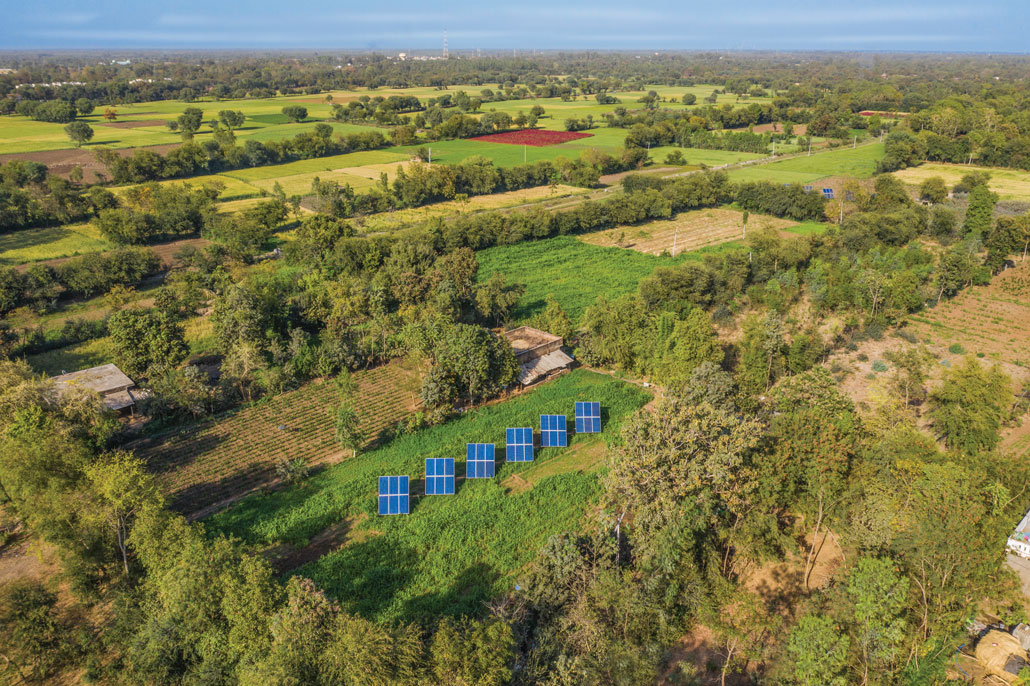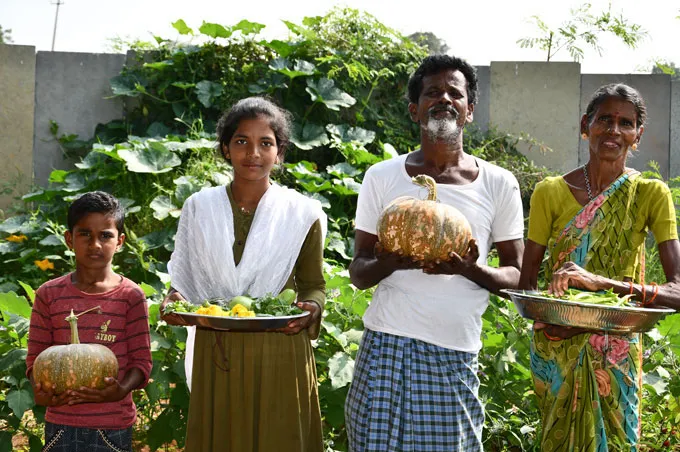Farmers in India cut their carbon footprint with trees and solar power
Climate-friendly agriculture offers new income sources and is more sustainable

A farmer in western India’s Dhundi village harvests rice. Solar panels power his water pump and bring in extra income.
IWMI-TATA Program, Shashwat Cleantech and Dhundi Saur Urja Utpadak Sahkari Mandali (DSUUSM)
In 2007, 22-year-old P. Ramesh’s groundnut farm was losing money. As was the norm in most of India (and still is), Ramesh was using a cocktail of pesticides and fertilizers across his 2.4 hectares in the Anantapur district of southern India. In this desert-like area, which gets less than 600 millimeters of rainfall most years, farming is a challenge.
“I lost a lot of money growing groundnuts through chemical farming methods,” says Ramesh, who goes by the first letter of his father’s name followed by his first name, as is common in many parts of southern India. The chemicals were expensive and his yields low.
Then in 2017, he dropped the chemicals. “Ever since I took up regenerative agricultural practices like agroforestry and natural farming, both my yield and income have increased,” he says.
Agroforestry involves planting woody perennials (trees, shrubs, palms, bamboos, etc.) alongside agricultural crops (SN: 7/3/21 & 7/17/21, p. 30). One natural farming method calls for replacing all chemical fertilizers and pesticides with organic matter such as cow dung, cow urine and jaggery, a type of solid dark sugar made from sugarcane, to boost soil nutrient levels. Ramesh also expanded his crops, originally groundnuts and some tomatoes, by adding papaya, millets, okra, eggplant (called brinjal locally) and other crops.

With help from the nonprofit Accion Fraterna Ecology Centre in Anantapur, which works with farmers who want to try sustainable farming, Ramesh increased his profits enough to buy more land, expanding his parcel to about four hectares. Like the thousands of other farmers practicing regenerative farming across India, Ramesh has managed to nourish his depleted soil, while his new trees help keep carbon out of the atmosphere, thus playing a small but important role in reducing India’s carbon footprint. Recent studies have shown that the carbon sequestration potential of agroforestry is as much as 34 percent higher than standard forms of agriculture.
In western India, more than 1,000 kilometers from Anantapur, in Dhundi village in Gujarat, 36-year-old Pravinbhai Parmar is using his rice farm for climate change mitigation. By installing solar panels, he no longer uses diesel to power his groundwater pumps. And he has an incentive to pump only the water he needs because he can sell the electricity he doesn’t use.
If all farmers like Parmar shifted to solar, India’s carbon emissions, which are 2.88 billion metric tons per year, could drop by between 45 million and 62 million tons annually, according to a 2020 report in Carbon Management. So far, the country has about 250,000 solar irrigation pumps out of an estimated 20 million to 25 million total groundwater pumps.
For a nation that has to provide for what will soon be the world’s largest population, growing food while trying to bring down already high greenhouse gas emissions from agricultural practices is difficult. Today, agriculture and livestock account for 14 percent of India’s gross national greenhouse gas emissions. Adding in the electricity used by the agriculture sector brings this figure up to 22 percent.
Ramesh and Parmar are part of a small but growing group of farmers getting assistance from government and nongovernmental programs to change how they farm. There’s still a ways to go to reach the estimated 146 million others who cultivate 160 million hectares of arable land in India. But these farmers’ success stories are testimony that one of India’s largest emitting sectors can change.

Feeding the soil, sustaining farmers
India’s farmers are already deeply feeling the effects of climate change, coping with dry spells, erratic rainfall and increasingly frequent heat waves and tropical cyclones. “When we talk about climate-smart agriculture, we are largely talking about how it has reduced emissions,” says Indu Murthy, sector head for climate, environment and sustainability at the Center for Study of Science, Technology and Policy, a think tank in Bengaluru. But such a system should also help farmers “cope with unexpected changes and weather patterns,” she says.
This, in many ways, is the philosophy driving a variety of sustainable and regenerative agricultural practices under the agroecology umbrella. Natural farming and agroforestry are two components of this system that are finding more and more takers across India’s varied landscapes, says Y.V. Malla Reddy, director of Accion Fraterna Ecology Centre.
“For me, the important change is the change in attitude of people towards trees and vegetation in the last few decades,” Reddy says. “In the ’70s and ’80s, people were not really conscious of the value of the trees, but now they consider trees, especially fruit and utilitarian trees, as also a source of income.” Reddy has advocated for sustainable farming in India for close to 50 years. Certain types of trees, such as pongamia, subabul and avisa, have economic benefits apart from their fruits; they provide fodder for livestock and biomass for fuel.
Reddy’s organization has provided assistance to more than 60,000 Indian farming families to practice natural farming and agroforestry on almost 165,000 hectares. Calculation of the soil carbon sequestration potential of their work is ongoing. But a 2020 report by India’s Ministry of Environment, Forest and Climate Change notes that these farming practices can help India reach its goal of having 33 percent forest and tree cover to meet its carbon sequestration commitments under the Paris climate agreement by 2030.
Regenerative agriculture is a relatively inexpensive way to reduce carbon dioxide in the atmosphere, as compared with other solutions. Regenerative farming costs $10 to $100 per ton of carbon dioxide removed from the atmosphere, compared with $100 to $1,000 per ton of carbon dioxide for technologies that mechanically remove carbon from the air, according to a 2020 analysis in Nature Sustainability. Such farming not only makes sense for the environment, but chances are the farmers’ earnings will also increase as they shift to regenerative agriculture, Reddy says.


Growing solar
Establishing agroecology practices to see an effect on carbon sequestration can take years or decades. But using renewable energy in farming can quickly reduce emissions. For this reason, the nonprofit International Water Management Institute, IWMI, launched the program Solar Power as Remunerative Crop in Dhundi village in 2016.
“The biggest threat climate change presents, specifically to farmers, is the uncertainty that it brings,” says Shilp Verma, an IWMI researcher of water, energy and food policies based in Anand. “Any agricultural practice that will help farmers cope with uncertainty will improve resilience to climate change.” Farmers have more funds to deal with insecure conditions when they can pump groundwater in a climate-friendly way that also provides incentives for keeping some water in the ground. “If you pump less, then you can sell the surplus energy to the grid,” he says. Solar power becomes an income source.
Growing rice, especially lowland rice, which is grown on flooded land, requires a lot of water. On average it takes about 1,432 liters of water to produce one kilogram of rice, according to the International Rice Research Institute. The organization says that irrigated rice receives an estimated 34 to 43 percent of the world’s total irrigation water. India is the largest extractor of groundwater in the world, accounting for 25 percent of global extraction. When diesel pumps do the extracting, carbon is emitted into the atmosphere. Parmar and his fellow farmers used to have to buy that fuel to keep their pumps going.
High groundwater use
Starting in the 1960s, India’s ground-water extraction began rising sharply, at a rate higher than in other places. This was primarily driven by the Green Revolution, a water- intensive agricultural policy to make the country food secure in the 1970s and ’80s and continues in some form even today.

“We used to spend 25,000 rupees [about $330] a year for running our diesel-powered water pumps. This used to really cut into our profits,” Parmar says. When IWMI asked him in 2015 to participate in a pilot solar-powered irrigation project with zero carbon emissions, Parmar was all ears.
Since then, Parmar and six fellow farmers in Dhundi have sold more than 240,000 kilowatt-hours to the state and earned more than 1.5 million rupees ($20,000). Parmar’s annual income has doubled from 100,000–150,000 rupees on average to 200,000–250,000 rupees.
The boost is helping him educate his children, one of whom is pursuing a degree in agriculture — an encouraging sign in a country where farming is out of vogue with the younger generation. As Parmar says, “Solar power is timely, less polluting and also provides us an additional income. What is not to like about it?”

Parmar has learned to maintain and fix the panels and the pumps himself. Neighboring villages now ask for his help when they want to set up solar-powered pumps or need pump repairs. “I am happy that others are also following our lead. Honestly, I feel quite proud that they call me to help them with their solar pump systems.”
IWMI’s project in Dhundi has been so successful that the state of Gujarat started replicating the scheme in 2018 for all interested farmers under an initiative called Suryashakti Kisan Yojana, which translates to solar power project for farmers. And India’s Ministry of New and Renewable Energy now subsidizes and provides low-interest loans for solar-powered irrigation among farmers.
“The main thing about climate-smart agriculture is that everything we do has to have less carbon footprint,” says Aditi Mukherji, Verma’s colleague and an author of February’s report from the Intergovernmental Panel on Climate Change (SN: 3/26/22, p. 7). “That is the biggest challenge. How do you make something with a low carbon footprint, without having a negative impact on income and productivity?” Mukherji is the regional project leader for Solar Irrigation for Agricultural Resilience in South Asia, an IWMI project looking at various solar irrigation solutions in South Asia.
Back in Anantapur, “there is also a visible change in the vegetation in our district,” Reddy says. “Earlier, there might not be any trees till the eye can see in many parts of the district. Now there is no place which doesn’t have at least 20 trees in your line of sight. It’s a small change, but extremely significant for our dry region.” And Ramesh and other farmers now enjoy a stable, sustainable income from farming.

“When I was growing groundnuts, I used to sell it to the local markets,” Ramesh says. He now sells directly to city dwellers through WhatsApp groups. And one of India’s largest online grocery stores, bigbasket.com, and others have started purchasing directly from him to meet a growing demand for organic and “clean” fruits and vegetables.
“I’m confident now that my children too can take up farming and make a good living if they want to,” Ramesh says. “I didn’t feel the same way before discovering these nonchemical farming practices.”






